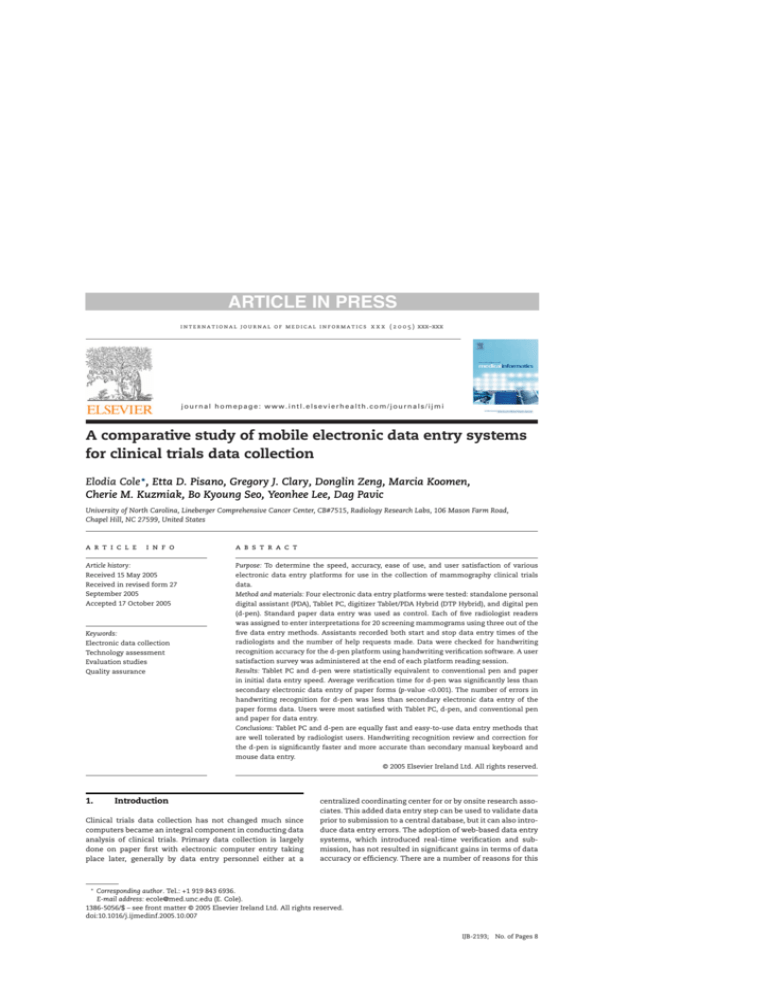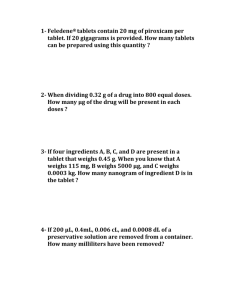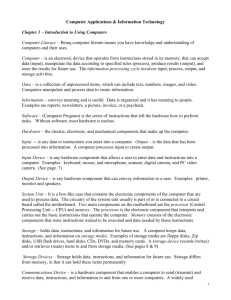
i n t e r n a t i o n a l j o u r n a l o f m e d i c a l i n f o r m a t i c s x x x ( 2 0 0 5 ) xxx–xxx
journal homepage: www.intl.elsevierhealth.com/journals/ijmi
A comparative study of mobile electronic data entry systems
for clinical trials data collection
Elodia Cole ∗ , Etta D. Pisano, Gregory J. Clary, Donglin Zeng, Marcia Koomen,
Cherie M. Kuzmiak, Bo Kyoung Seo, Yeonhee Lee, Dag Pavic
University of North Carolina, Lineberger Comprehensive Cancer Center, CB#7515, Radiology Research Labs, 106 Mason Farm Road,
Chapel Hill, NC 27599, United States
a r t i c l e
i n f o
a b s t r a c t
Article history:
Purpose: To determine the speed, accuracy, ease of use, and user satisfaction of various
Received 15 May 2005
electronic data entry platforms for use in the collection of mammography clinical trials
Received in revised form 27
data.
September 2005
Method and materials: Four electronic data entry platforms were tested: standalone personal
Accepted 17 October 2005
digital assistant (PDA), Tablet PC, digitizer Tablet/PDA Hybrid (DTP Hybrid), and digital pen
(d-pen). Standard paper data entry was used as control. Each of five radiologist readers
was assigned to enter interpretations for 20 screening mammograms using three out of the
Keywords:
five data entry methods. Assistants recorded both start and stop data entry times of the
Electronic data collection
radiologists and the number of help requests made. Data were checked for handwriting
Technology assessment
recognition accuracy for the d-pen platform using handwriting verification software. A user
Evaluation studies
satisfaction survey was administered at the end of each platform reading session.
Quality assurance
Results: Tablet PC and d-pen were statistically equivalent to conventional pen and paper
in initial data entry speed. Average verification time for d-pen was significantly less than
secondary electronic data entry of paper forms (p-value <0.001). The number of errors in
handwriting recognition for d-pen was less than secondary electronic data entry of the
paper forms data. Users were most satisfied with Tablet PC, d-pen, and conventional pen
and paper for data entry.
Conclusions: Tablet PC and d-pen are equally fast and easy-to-use data entry methods that
are well tolerated by radiologist users. Handwriting recognition review and correction for
the d-pen is significantly faster and more accurate than secondary manual keyboard and
mouse data entry.
© 2005 Elsevier Ireland Ltd. All rights reserved.
1.
Introduction
Clinical trials data collection has not changed much since
computers became an integral component in conducting data
analysis of clinical trials. Primary data collection is largely
done on paper first with electronic computer entry taking
place later, generally by data entry personnel either at a
centralized coordinating center for or by onsite research associates. This added data entry step can be used to validate data
prior to submission to a central database, but it can also introduce data entry errors. The adoption of web-based data entry
systems, which introduced real-time verification and submission, has not resulted in significant gains in terms of data
accuracy or efficiency. There are a number of reasons for this
∗
Corresponding author. Tel.: +1 919 843 6936.
E-mail address: ecole@med.unc.edu (E. Cole).
1386-5056/$ – see front matter © 2005 Elsevier Ireland Ltd. All rights reserved.
doi:10.1016/j.ijmedinf.2005.10.007
IJB-2193;
No. of Pages 8
2
i n t e r n a t i o n a l j o u r n a l o f m e d i c a l i n f o r m a t i c s x x x ( 2 0 0 5 ) xxx–xxx
including the limited mobility of computer hardware and the
lack of availability of on-line data accuracy checks (i.e. desktop
personal computers far removed from location where data
is initially acquired) [1]. Today there are a number of mobile
devices that are used in other data collection applications that
could readily be used for clinical trials data collection. The personal digital assistant (PDA), Tablet personal computer (Tablet
PC), digital pen (d-pen), and digitizer Tablet/PDA Hybrid (DTP
Hybrid) have all shown usefulness for mobile computing purposes [2–5] in the medical field. The PDA has been extensively
tested and has shown mixed results as a data collection tool by
physician users [6,7] and patient users [8] based on the application. The large-scale implementation of any of these data
collection devices for a clinical trial without some evidence of
their reliability in the field could prove disastrous both monetarily and in subsequent poor quality of patient care that could
result.
The purpose of this project was to determine which of
four mobile electronic devices are most suitable for clinical
trials data collection in our mammography clinic by assessing the speed, accuracy, ease of use, and satisfaction by
radiologists, who are one group of potential users of these
devices for primary data collection in medical imaging clinical
trials.
2.
Methods and materials
Four different mobile electronic devices were tested – a Tablet
PC (M1300, Motion Computing Inc., Austin, TX) (Fig. 1), an dpen (Logitech io, Logitech, Fremont, CA) (Fig. 2), a DTP hybrid
(Mi-Forms Pad, Mi-Co, RTP, NC/Dell Axim, Dell Inc. Round
Rock, TX) (Fig. 3), and a PDA (Dell Axim, Dell Inc., Round Rock,
TX) (Fig. 4). Forms software (Mi-Forms, Mi-Co, Research Triangle Park, NC) was installed on each device allowing for data
transmission to a centralized server via standard communications protocols. Conventional pen and paper completion
of a form by the radiologist with secondary electronic data
entry by an administrative assistant was the control condition.
Five radiologists participated in this study using a standard
research form created in our clinic for the collection of mammography interpretation information. The paper form was
converted into electronic formats suitable for display on each
of the four hardware devices using form designer software
(Mi Forms Designer, Mi-Co, Research Triangle Park, NC). There
were a total of 119 data elements on the paper forms. The
data elements were implemented as option buttons, check
boxes, constrained text, and free text. Not every element
was required to be completed on the form, so conditional
statements were programmed to allow for pre-defined skip
patterns.
Each radiologist reader was assigned to three out of five
data entry platforms. Each reader interpreted 20 de-identified
screening mammograms from our digital mammography
research files on each of the three assigned platforms. The
study was conducted in our research laboratory. A research
assistant recorded the start time and end time of data entry
for each case. The number of help requests required for each
of the data entry systems was also recorded as a measure of
ease of use. The data were checked for accuracy in charac-
ter recognition using data verification tools (Fig. 5) and then
submitted to a centralized database for this study. An administrative assistant entered all data collected on paper into
a computer application that simulated the process of webbased data entry. The administrative assistant was to review
the data he entered into the computer application and verify
that it matched the source document paper form prior to submitting the information to the centralized database for this
study.
2.1.
Statistical methods
2.1.1.
Speed Analysis
A research assistant recorded the time of completion of each
form during the reading sessions. Analysis of variance was
used to determine if the initial data entry speed differed
between each of the devices tested. The Shapiro-Wilk test
indicates that the time spent in reading is skew-distributed.
However, the log-transformed time appears to satisfy the normality assumption. The first analysis was to fit a generalized
linear model to the data, where the response used in the model
is the log-transformed time spent in reading and the design
matrix includes the factors of 5 devices, 5 readers, and 20
cases. The R2 was 0.69, which shows that the generalized linear model fits the data very well. The residual analysis from
the fitted model further shows that the model used for analyzing data is valid.
2.1.2.
Accuracy
Three radiologists read 20 cases using both the d-pen and conventional pen and paper. One additional radiologist read 20
cases using conventional pen and paper. A data entry operator entered the data forms from these 80 cases manually via
mouse and keyboard into a desktop computer. Comparison of
manual data entry was made to Mi-Forms verification and correction, where a verifier/corrector checks to make sure that the
handwriting recognition captured matches the information
recorded on the paper source. The number of data entry errors
was determined by cross checking the source paper document
to the information entered into the electronic database by the
data entry operator (or the verifier/corrector in the case of MiForms verification). The accuracy was recorded and expressed
as the percentage of cases for which one error, two errors, or
more than two errors were made for each of the two data entry
methods.
2.1.3.
Ease of use analysis
The number of help attempts was assumed to follow a Poisson distribution with rate varying from device to device, reader
to reader, and even case by case. Since conventional pen and
paper required no technical usage help, it was necessary to
compare the performance of the remaining four devices. The
observations associated with conventional pen and paper was
excluded from the data and a generalized linear model with
log-link function was fitted for this Poisson data with the
remaining devices.
2.1.4.
User satisfaction analysis
In the survey data for the readers’ satisfaction, the four aspects
of how simple to start using, how comfortable to use and
i n t e r n a t i o n a l j o u r n a l o f m e d i c a l i n f o r m a t i c s x x x ( 2 0 0 5 ) xxx–xxx
3
Fig. 1 – Tablet PC screen shot: a Tablet PC has the functionality of a laptop with the added benefit of a screen, stylus data
entry similar to a PDA. The interface can be made to mimic a paper form except there is the ability to create logic checks
that can prevent some common data entry problems, e.g., numbers out of acceptable range.
hold, how natural the feel of writing, and how easy to change
between worksheets were evaluated by the five readers for
each of the three devices they tested. Particularly, all five
readers evaluated the DTP hybrid and Tablet PC; one reader
evaluated PDA; one reader evaluated conventional pen and
paper, and three readers evaluated the d-pen. User satisfaction
scores ranged from 1 to 5 (from strongly disagree to strongly
agree).
3.
Results
3.1.
Speed
The analysis of variance indicated that the times spent entering data were significantly different among the five devices (pvalue <0.001), among five readers (p-value <0.001), and among
4
i n t e r n a t i o n a l j o u r n a l o f m e d i c a l i n f o r m a t i c s x x x ( 2 0 0 5 ) xxx–xxx
20 cases (p-value <0.001). The Tukey test with significance level
0.025 showed that after controlling the confounding effects
due to readers and cases, the time spent using the DTP hybrid
was significantly longer than the time spent using the d-pen,
conventional pen and paper, and Tablet PC (all p-values <0.01)
(Fig. 6). There was no significant difference between the time
spent using the DTP hybrid and the time spent using the PDA
only (p-value = 0.17). The data entry methods from fastest to
slowest were conventional pen and paper entry, Tablet PC,
d-pen, DTP hybrid and PDA. The speed difference between
conventional pen and paper, d-pen, and Tablet PC was not significant (all pairwise p-values are larger than 0.85).
3.2.
Fig. 2 – d-pen: paper pre-printed with a fine, unique dot
patterned background for each page of every form must be
used. The tip of the pen has a little camera that records
images of the dot pattern which is uniquely arranged
across the page. The result is an exact electronic replica of
the handwritten page.
Ease of use
The ease of use of the data entry systems was determined
based on the percentage of cases with at least one request
for help. The PDA was the hardest to use with 70% (14/20) of
the cases reviewed requiring the user to seek assistance in
getting the data into the electronic device. The percentage of
cases with help requests were 42% (42/100) for the DTP hybrid,
14% (14/100) for the Tablet PC, and 8.3% (4.98/60) for the dpen. There was no significant difference in the number of help
attempts observed between the d-pen and the Tablet PC (pvalue = 0.26).
3.3.
Accuracy
Handwriting recognition verification software (Mi-Forms, MiCo) was used to verify quality of computer interpretation of
data collected by the d-pen. The average time spent by a data
entry operator for verification of captured electronic data for
the d-pen was significantly less than secondary electronic data
entry and verification of paper forms (p-value <0.001). The
number of errors in handwriting recognition for the d-pen was
less than the number of transcription errors based on secondary data entry of the conventional pen and paper forms
data. A total of 27.5% of cases had at least one data entry error
for secondary entry of paper forms. About 10% of cases had
at least two errors and 6.25% had at least three errors. With
the d-pen, 13.33% of the cases had at least one handwriting
recognition error, 3.33% of the cases had at least two errors,
and none of the cases had more than two errors.
3.4.
User satisfaction
There were no significant differences in user satisfaction
among the DTP hybrid, PDA, and conventional pen and paper
(Fig. 7). However, the DTP hybrid, and PDA alone had significantly lower scores than either Tablet PC or d-pen (p-value
< 0.003). The Tablet PC and d-pen were not significantly different from each other (p-value = 0.96).
4.
Fig. 3 – PDA screen-shot: stylus data entry able to fit into
the palm of your hand. This device is extremely portable
and lightweight. Small screen makes it unsuitable for
wordy data elements. Although there is scroll capability, it
can be a little cumbersome.
Discussion
Conversion from paper primary data entry to electronic data
entry will not result in error free data collection but minimizing data entry errors resulting from an extra data entry step
will certainly help in the data clean-up stage of clinical tri-
i n t e r n a t i o n a l j o u r n a l o f m e d i c a l i n f o r m a t i c s x x x ( 2 0 0 5 ) xxx–xxx
5
Fig. 4 – DTP Hybrid: standard paper forms are positioned on a special tablet. Each form has an electronic XML definition to
which data is stored upon entry of check box, option box or text. A PDA acts as the computing engine, performing real-time
logic checks of the data that is entered.
als. No matter how sophisticated the central data collection
system database, ultimately a clinical trial’s data quality rests
in the hands of the individual sites so it becomes imperative
that an understanding of the practical usage of the prospective
data collection system take into consideration system features
(Table 1) and the user requirements.
4.1.
The data entry platforms
4.1.1.
Tablet PC
for accuracy prior to uploading to the study database, which
can be done immediately or following verification at some set
time in the future as a batch process. Tablet PCs today can be
wireless-enabled or blue-tooth-enabled for communications
to and from the study database server. Cross-outs are traceable and electronically time stamped and maintained with the
source handwritten form electronic form.
4.1.2.
A Tablet PC has the functionality of a laptop with the added
benefit of a screen with stylus data entry like that of a PDA.
Tablet PCs at the moment are the most expensive laptop computers on the market. A large screen that is roughly the size of
a piece of paper makes it visually appealing. Normally around
3–4 pounds in weight, it is easily portable from one room to
another. The interface can be made to emulate a paper form
and logic checks can be built in to prevent some common
data entry problems. For example, this system can prevent
input of a number that is outside an acceptable range of values. The Tablet PC is handwriting recognition capable and
allows for handwritten signature capture. A source document
is generated and can be printed, if needed, or permanently
stored electronically. All of the handwriting is converted to
computer text in a separate file, where the data can be verified
Personal digital assistant (PDA)
This electronic data entry system also has touch screen stylus
data entry. This device is extremely portable and lightweight.
The small screen makes it poorly suited for lengthy data elements, and although there is scroll capability, it can be somewhat difficult to navigate. Logic checks can be built in and
data can be instantly uploaded to a study database with wireless functionality or by docking to a cradle. This is a relatively
inexpensive system, even with wireless capability. Handwriting recognition is built in. There is, however, immediate conversion to typed text with no handwritten source document
stored. The verification step takes place usually after uploading the forms to a computer with a larger screen, although it
can be done on the small screen. This device is most useful
when there are a limited number of data elements with few
text box entries. This system is impractical for forms with any
number of data elements over 20 or 30. However, the PDA could
6
i n t e r n a t i o n a l j o u r n a l o f m e d i c a l i n f o r m a t i c s x x x ( 2 0 0 5 ) xxx–xxx
Fig. 5 – Mi-Forms verification software. Useful for verifying that handwritten fields (like case number) are correctly
interpreted by the handwriting recognition software. Also can be used to verify data entry completion and logic prior to
submission to a backend database.
Fig. 6 – The average time spent by radiologist entering data
for each data entry method.
Fig. 7 – Average satisfaction rating of each data entry
method.
7
i n t e r n a t i o n a l j o u r n a l o f m e d i c a l i n f o r m a t i c s x x x ( 2 0 0 5 ) xxx–xxx
Table 1 – Comparison of data entry systems – key features useful for data collection and verification
System features
Pen-on-paper interface
Immediate validations
Offline validations
Real-lime handwriting recognition
Deferred handwriting recognition
Deferred correction of recognition errors
Picklists
Real-lime capture to database
Store-and-forward capture to database
Hardware cost (approximate)
Handheld (“PDA”)
system
×
×
×
×
×
×
×
×
$500
“Tablet PC”
system
Hybrid handheld/pen-on-paper
system “DTP Hybrid”
Digital pen
system “d-pen”
×
×
×
×
×
×
×
×
×
$900
×
×
×
×
×
×
×
×
×
$2000
easily be used for a checklist or short form such as those used
by research associates to determine eligibility criteria and to
retrieve pre-generated study identification numbers from a
centralized database.
4.1.3.
Digitizer Tablet/PDA Hybrid (DTP Hybrid)
If a paper trail is desired, the DTP Hybrid electronic data entry
system will provide one. Standard paper forms are positioned
on a special tablet. Each form has an electronic match to which
data is dumped upon entry of a check box, option box, or text.
A PDA performs real-time logic checks of the data after it is
entered into the PDA but before upload to the study database.
Correct form interpretation is conducted through a complex
set of navigations that involve touching a specific box on the
top of the paper forms and hitting specific locations on the
bottom of a form that allow the user to skip around multiple
forms. This system is not well suited for multi-page forms. Our
radiologist interpretation form when adapted to this system
ended up being 27 pages long. While skip patterns can help
alleviate some of the navigation problems, there were still 27
pages of paper forms for each case using this system.
As with the PDA alone, there is the capability of immediate upload to a database if the PDA has wireless capability.
Data verification can similarly be done using the PDA screen
or after transferring data to another computer. The digitizer
tablet itself is roughly 10 × 13 in. with a tethered pen that is to
be used to complete the forms, which are readily printed as
needed.
4.1.4.
Digital pen (d-pen)
This is yet another mobile device with the ability to produce
a paper-based source trail if required. Paper with unique dot
patterns for each page of every form is initially created. This
special dot-patterned paper can be printed out from specific
types of laser jet printers or pre-printed forms can be ordered
from a printing house for high volume applications.
There are additional costs associated with printing the
forms but the d-pen itself is really inexpensive. The tip of the
d-pen contains a tiny camera that records images of the dot
pattern, which is uniquely arranged across the page. From
the uniquely arranged dot patterns, the d-pen computes a
sequence of positions corresponding to the handwriting trace.
The result is an exact electronic replica of the handwritten
page. The d-pen has a docking station to upload all data collected, but this does not have to be done after each and every
×
×
×
×
$200
case. The d-pen can store over 100 forms at one time. To the
user, it is like using conventional pen and paper but with
an electronic replica that can be electronically stored so that
handwriting recognition software can be used to verify information without typing all of it with immediate upload to a
study database. There is no learning curve since using this
device is intuitive and like using a regular pen. However, there
are no real-time logic checks of the data. The d-pen is ideal for
patient data entry, especially for consent and history forms.
4.2.
User requirements
When introducing new technology, a basic understanding of
the user requirements can save time and money. The user
group tested in this study was academic radiologists who
are experts in mammography. The environment was carefully
controlled reading room (outside of normal clinical environment, controlled for noise and distraction). Our results presented here are specifically for this user group within a controlled environment. The results for our radiologists may differ
in their hectic clinical environment. The needs of other clinicians and medical professionals working in other types of
clinical environments may differ as well.
The academic radiologists in our experiment participate in
numerous clinical trials and visual perception studies so they
are accustomed to filling out research forms. The key issue for
our users in regards to completing research paperwork beyond
normal clinically required documentation is the time it takes
to complete the forms. The total time would include not only
the time it takes for them to initially complete the form but
also the time it takes for them to correct the form if errors are
found. The four parameters we chose to look at when assessing the most suitable electronic data collection systems not
only take into consideration the requirements of our radiologists but also issues that will influence the quality of the data
collected.
4.2.1.
Speed
Most of the time research forms are completed in the clinic
during breaks or at the end of their clinical workday. Navigation through forms must be intuitive or guided through
business rules based on response. In this study, the form had
multiple parts, which were completed when necessary, based
on the findings seen on the mammograms that the radiologists reviewed.
8
4.2.2.
international journal of medical informatics
Ease of use
There is always a learning curve associated with any type of
data collection. It inevitably will take the radiologist longer
to complete a paper form when they first start a trial but this
time should diminish as they become more familiar with order
and options of the data elements on the paper forms. For this
study, three out of the five radiologist participants had experience with the order and options of data elements on the forms
because they had used the forms for various clinical trials. In
choosing to move to an electronic format, we must consider
not only the learning curve for the form content but also the
learning curve for the data entry system. The learning curve to
use an electronic data entry system should be proportionate to
the extent of use. In other words, the radiologist and research
associate who will presumably complete study forms for the
one or two years of data collection will have extensive training
in data collection for a clinical trial. However, their efficiency
with a device to capture that information will rest in the frequency of use.
4.2.3.
Accuracy
The type of error that can be minimized by the introduction
of direct electronic data entry is the transcription data entry
error. The data entry personnel who may be the research associate on site or professional typists of the sponsor are charged
with data entry and verifying the completeness of the forms.
When errors are found prior to transcription of the information from a paper form into the electronic database that will
be used to house the information for future analysis, the data
entry personnel can request clarification from the person who
is the source of the information. Otherwise, the error goes
downstream to the statistical center. Either way, clarification
is required which may go undetected for months or even years
after the data was initially collected. Removing the secondary
data entry step would ideally minimize this type of error, as
the validation step could be the primary concern of the data
management team as opposed to both data entry and validation.
The other type of error is the logic error, which is misinterpretation of the question asked or skipping required fields.
The ability to perform real-time logic checks as the data is
being collected will assist in minimizing logic errors.
4.2.4.
User satisfaction
The reason why paper data collection dominates in our
research environment is because the radiologists have found
every computer interface designed to collect information from
them within the clinical environment to be cumbersome to
use. There are few options in regards to the hardware used to
enter data electronically for a clinical trial as the sponsor of
the clinical trial dictates the data collection methods; other
than complete a paper form and have someone else on your
staff worry about entering the data electronically. If the radiologists are comfortable using an electronic device to enter the
information they are required to for a study, they will use it so
xxx
( 2 0 0 5 ) xxx–xxx
long as it does not significantly add to the amount of time it
takes them to complete the form.
5.
Conclusion
In this study, the Tablet PC and the d-pen were equally fast and
equally easy to use data entry methods. Both were faster and
easier to use than the PDA and DTP Hybrid alternatives. Users
were equally satisfied with the d-pen and Tablet PC according to a survey, and more satisfied with those two platforms
than with the PDA and DTP Hybrid alternatives. Handwriting
recognition results review and correction using Mi-Forms for
the d-pen was significantly faster and more accurate than secondary manual keyboard and mouse data entry.
In evaluating and selecting and electronic data entry system, the end user, their working environment, and the form
design are key aspects in successful data collection. Our study
was designed to test how effective various devices, when fitted
with a single vendor’s commercially available software solution, would hold up in data collection of clinical trial data
provided by radiologists within the context of an ongoing
research project. The results presented here may differ with
other forms software. While the results presented here are
unique to the form design, data elements, training, and experiment environment of our tested users, we believe that the
results provide important information in assessing the relevance of various electronic data capture devices for any data
collection purpose given specific use requirements.
references
[1] R.G. Marks, Validating electronic source data in clinical
trials, Control. Clin. Trials 25 (5) (2004) 437–446.
[2] J.R. Barrett, J.R. Schubart, W.F. Cohn, S.M. Strayer, Medical
residents compare PC Tablet handheld and desktop
applications, Medinfo 2004 (CD) (2004) 1516.
[3] K. Kotani, K. Horii, An analysis of muscular load and
performance in using a pen–tablet system, J. Physiol.
Anthropol. Appl. Hum. Sci. 22 (2) (2003) 89–95.
[4] R.S. Laskin, J.P. Davis, The use of a personal digital assistant
in orthopaedic surgical practice, Clin. Orthop. 421 (2004)
91–98.
[5] L. Lind, D. Karlsson, Digital pen technology in palliative
home healthcare, Medinfo 2004 (CD) (2004) 1723.
[6] A.E. Carroll, P. Tarczy-Hornoch, E. O’Reilly, D.A. Christakis,
The effect of point-of-care personal digital assistant use on
resident documentation discrepancies, Pediatrics 113 (3 (Pt
1)) (2004) 450–454.
[7] C. Jao, D.B. Hier, J. Su, Evaluating a digital resident diagnosis
log: reasons for limited acceptance of a PDA solution, AMIA
Ann. Symp. Proc. (2003) 876.
[8] K. Keshavjee, M.L. Lawson, M. Malloy, S. Hubbard, M. Grass,
Technology failure analysis: understanding why a diabetes
management tool developed for a personal digital assistant
(PDA) didn’t work in a randomized controlled trial, AMIA
Ann. Symp. Proc. (2003) 889.








